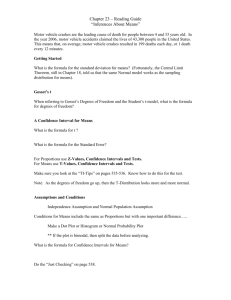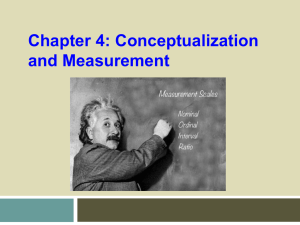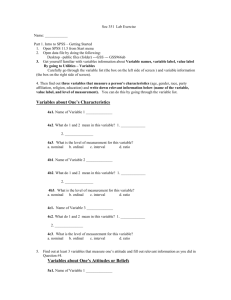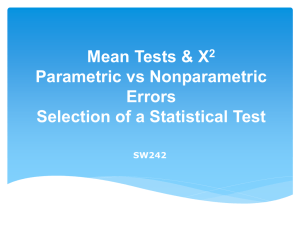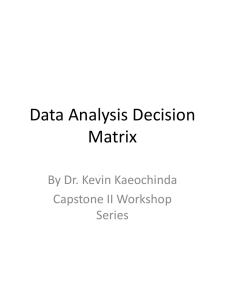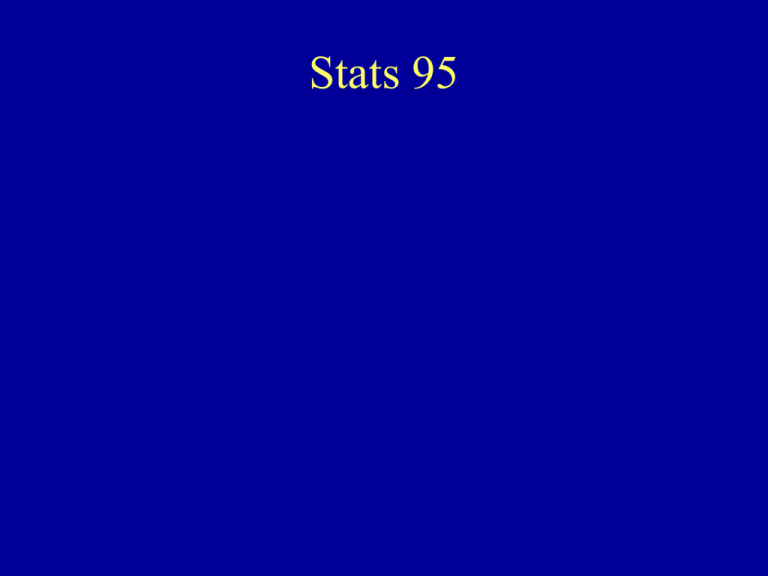
Stats 95
Two Branches Of Statistics
Descriptive
• Organize
• Summarize
• Communicate
… a body of observed data
• Describe a Population or a
Sample
Inferential
• Using sample data to make
estimates of the rest of the
population
• Can infer only from a
Sample to the Population
Populations & Samples
or Why Stats Is All Greek To Me
Population
• Includes ALL POSSIBLE
OBSERVATIONS
• Greek Letters
Sample
• A set of observations from a
population
• Roman Letters
Experiment Variables
Research Variables
•
•
•
•
Independent Variable
Dependent Variable
Extraneous Variables
Confounding Variable
• Vary systematically with Independent Variable
• E.g., Income & Health, very often wealthy people are the
healthy ones
• Can (usually) solve by good design or by limiting scope of
conclusion, or controlling statistically
•
http://stattrek.com/experiments/experimental-design.aspx
What Are You Counting?
• Types of Data (“Quantitative Variables”)
Nominal
Ordinal
Interval
Mutually Exclusive
Categories
Mutually Exclusive
Categories, Ordered
Mutually Exclusive,
Ordered, Regular Intervals
Mutually Exclusive, Ordered,
Ratio Regular Intervals, Proportional
(Absolute Zero)
Desktop Laptop
iPhone
Ford, GM, Honda
Freshman, Junior Senior;
Agree, Neutral, Disagree
Degrees Celsius
Nielsen Ratings
Degrees Kelvin
$$$ Time
Discussion
• What Kind of Quantitative Variables (Nominal, Ordinal, Interval,
Ratio):
– Please list all the languages you can speak
– What is your academic standing?
– How many friends do you have on Facebook? (0-100, 101-200,
201-300…)
– Please type in the exact number of friends you have on
Facebook.
– What is your height in inches?
– Rate how strongly you are for or against gay marriage.
– How many siblings do you have?
• The answers are not always cut and dry, but influenced
by the question you are asking!
Summary
Experience Counts
Usability
Test
Statistical Test
Data Type
Rank
Order
Chi-square
Nominal,
Ordinal
Benchmar
k
Single-sample ttest
Ratio,
Interval
A|B (Ind)
Independent
sample t-test
A|B (Dep)
Dependence /
Independenc
e
Sample
Size
Dependent
5 per cell
1
Independent
12
Ratio,
Interval
2
Independent
12 x 2
Dependent sample
t-test
Ratio,
Interval
2
Dependent
8-12
Survey
Correlation
Ratio,
Interval
2
Dependent
8-12
A|B+
ANOVA
Ratio,
Interval
2 or more
Independent
8-12 /
level
A|B+ (RM)
RepeatedMeasures ANOVA
Ratio,
Interval
2 or more
Dependent
8-12
7
Copyright © 2013, Oracle and/or its affiliates. All rights reserved.
# of
Variables
1 or 2
Decision Tree
Start
# of
variables
> 1?
Yes
Yes
# of
variables
> 2?
No
Δ b/w
means?
Multiple
Regression
Yes
No
Continuous
variables?
Continuous
Variable?
Yes
Independent
observations?
Δ b/w
means?
RepeatedMeasures
ANOVA
(A|B+)
Yes
Yes
Population
σ?
Correlation
Independent
observations?
Yes
Yes
No
Yes
Singlesample t-test
(Benchmark)
8
Singlesample z-test
(Benchmark)
Copyright © 2013, Oracle and/or its affiliates. All rights reserved.
Chi-square
Chi-square
(Rank Order;
Goodness of
Fit)
(Rank Order;Test
of Independence)
Dependent
t-test
(A|B)
One-Way
ANOVA
(A|B+)
Independent
t-test
(A|B)
The End
• Next week: Bring a Bag of Chocolate Chip
Cookies!
• Back Up Slides
What Are You Counting?
• Types of Data (“Quantitative Variables”)
Ratio
Proportional
(Absolute Zero)
Interval
Regular Intervals
$$$
Time
Ratings
Scale
Ordinal
Ordered but Irregular
Nominal
Labels or Names
Lickert Scale 1-7
Agree Neutral
Disagree
Desktop Laptop
iPhone
Data Variables
Quantitative Variables: Discrete or Continuous
• Discrete
– Nominal
• Purely qualitative, no ordering is
possible, category or name
• E.g., Toyota, Ford, Honda; Breast
Cancer, Throat Cancer, Lung
Cancer
– Ordinal
• Where there is a sequential order,
but the intervals are irregular
• E.g., First, Second, Third;
Freshman, Sophomore, Junior
• Continuous (can be
Discrete)
– Scale
– Sequential order, and the
intervals are regular, but values
are not proportional, no
Absolute Zero
• E.g., degrees Fahrenheit or
Celsius
– Ratio
• Regular intervals which are
proportional, there is an
Absolute Zero
• E.g., degrees Kelvin, Height
Where Does Data Come From?
•
•
•
•
•
•
Case Studies
Experiments
Naturalistic / quasi-experimental
Longitudinal
Cross-sectional
Surveys
The Science of Observation
• Theory: Statement of relationship
– Amongst events otherwise unrelated
– For which there is already supportive data (a
theory is more than an idea)
• Hypothesis: Statement of possible relationship
between variables which follow logically (but
sometimes unexpectedly!) from theory
Experiments
Looking for a Difference
Between-Groups
• Participants experience only
one level of the independent
variable.
– E.g., one group performs their
driving license exam after
consuming alcohol, and the
other group performs the test
sober.
Within-Groups
• Participants experience all
levels of the independent
variable.
– All members take the driving
license exam twice, once after
consuming alcohol, and again,
sober.
The Science of Observation
• Experiment: Test of hypothesis with 2 critical
elements
• (1) Manipulation
– independent variable
– dependent variable—measured
– control group
– experimental group
• (2) Randomization (controls for 3rd variable)
– versus self-selection
Operational Definition
• DVs that aren’t subject to biased responses
• Examples:
– Is a painting in a museum popular?
• There will be increased wear on the carpet near it.
– Did a dental flossing lecture work?
• Students will have cleaner teeth the next day.
– Did a safer sex intervention for commercial sex
workers work?
• There will be more condoms discarded in the park they
work in.
Random Sampling and
Confounding Variables
• National polls in this country can be
dated back to the early 1800's.
• The largest of these was Literary Digest,
tried to
• determine the outcome of the 1936
presidential election (Franklin D.
Roosevelt and Alfred Landon).
• They sent out 10 million questionnaires
using lists from phone books, vehicle
registration lists, and club memberships
across the country, from which 2.4
million responded!
• Today, polls typically rely on the
opinions of 500-1000 people.
• Potential problems???
Correlation
Looking for a Relationship
• Correlation measures the strength of a
relationship between two variables, and the
direction of the relationship, positive or
negative.
Data From Survey
GPA
Hours of Study and GPA
4.5
4
3.5
3
2.5
2
1.5
1
0.5
0
R = - 0.11
Series1
Linear (Series1)
0
10
20
30
40
Hours of Study (weekly avg.)
The Science of Observation
• Validity—able to draw accurate inferences
– construct validity: e.g., describing what intelligence is
and is not, “construct” refers to the “theory”
– predictive validity: over time you find X predicts Y
• Reliability—same result each time?
20
Data From Survey
Hours of Working Out & Sex
Hours of Study Per Week &
Sex
8
7
14
12
6
10
5
8
4
Total
6
3
4
2
2
1
0
Female
14
Total
0
Male
Female
12
10
8
Average of GPA
6
Average of Study
4
2
0
Female
Male
Male
25
Weight and Weekly Avg Hours of Exercise
20
15
Series1
10
Series2
5
0
0
50
100
150
200
250





